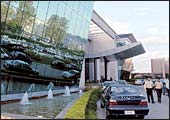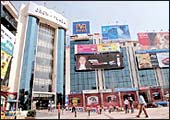|
In
March this year, the Haryana Urban Development Authority (HUDA)
announced sale of 5,200 freehold plots, and how many people queued
up to buy? 50,000? 100,000 or perhaps 500,000? If you picked the
last figure, you'd still be off by a huge margin. A staggering
2 million applicants thronged HUDA's offices and bank branches
where the forms were being sold. HUDA, on its part, can't stop
grinning. It made a cool Rs 10 crore just selling the forms, and
expects to make another Rs 600 crore from interest income on the
earnest money.
In March too, the Delhi Development Authority
(DDA) put up sites on the outskirts of Delhi for sale, including
Jasola, Okhla, Rohini, Motia Khan and Shahdara Central Business
Districts. As made evident by its total reserve price for all
the sites, DDA thought those pieces of real estate were worth
at least Rs 533 crore. How much did DDA end up with? Surprise:
Rs 943 crore. It helped that there were as many as 20 bidders
jostling for some of the plots. The Emaar-MGF Land (Emaar is a
Dubai-based realty giant that is building Burj Dubai, which could
become the world's tallest building when completed in 2008) combine
bought two adjacent plots in Jasola for Rs 388 crore; DDA's reserve
price for them: Rs 118 crore.
 |
 |
Gurgaon
In Gurgaon and Noida, prices have jumped by as much as 200
per cent. The cheapest DLF apartment in Gurgaon (among the
newer projects) costs Rs 1 crore |
Mumbai
In Mumbai, rates of residential properties in places like
Cuffe Parade have shot up from Rs 11,500 per sq. ft three
years ago to Rs 25,000 now |
 |
 |
Sonepat
The property boom has rapidly spread across small town India.
Drive by places like Sonepat, Coimbatore, Jodhpur or even
Vijayawada, and you'll see new buildings coming up |
Chandigarh
The planned nature of Chandigarh has always had an appeal.
And now with the city being preferred by IT companies, there
is a spurt in real estate demand |
Earlier in February, a consortium comprising
Maytas Properties (that's Satyam spelt backwards), Nagarjuna Construction
Company and ICICI Venture made real estate history when it plonked
down Rs 335.25 crore for 5.8 acres of land in the city's upmarket
Jubilee Hills. The price per square foot works out to an astonishing
Rs 13,000-plus. The buyers apparently plan to build a luxury hotel
on the site.
What's happening? In a country that boasts
of the seventh-largest land mass in the world, why are buyers
behaving as if land is running out of supply? Make no mistake,
though. The real estate mania, as illustrated by the preceding
examples, is hardly the ailment of a few buyers in a handful of
cities. Over the last three years or so, the real estate market
has simply exploded. In Mumbai, rates of residential properties
in places like Cuffe Parade have shot up from Rs 11,500 per sq.
ft three years ago to Rs 25,000 now. In Delhi's satellite cities
of Gurgaon and Noida, prices have jumped by as much as 200 per
cent. Bangalore's realty has surged too (see Pay Dirt). But what's
not so intuitive about the property boom is its rapid spread across
small town India. Drive by places like Sonepat, Ludhiana, Coimbatore,
or even Jodhpur and Vijayawada, and you'll see new buildings coming
up all around (see Cities Of Joy on page 134). Says Sanjay Verma,
Jt Managing Director of Cushman & Wakefield, a real estate
consultancy: "The development in Tier II cities such as Pune
has accelerated at such a pace that some of these cities are graduating
to Tier I grade."
 |
"The current price rise is a
bubble fuelled by developers. Where else do you see prices
rising like this? Present buyers (of residential properties)
are unlikely to be end users"
Deepak Parekh
Chairman/ HDFC |
What's Behind The Boom?
To answer in a word, demand. Underlying it,
though, are some key macro-economic reasons. One, the country's
growth. The economy has been growing at over 7 per cent over the
last three years (including 2005-06, where the estimates point
to an over 8 per cent growth), boosting not just business confidence,
but also consumer sentiment. A number of sectors such as it and
ITEs, retail, hospitality, healthcare, and entertainment have
grown rapidly, gobbling up acres of land. To add to it, interest
rates have actually come down from high teens to about 9 per cent,
giving rise to an EMI (equated monthly instalment) economy, where
even a Rs 30-lakh apartment is affordable to a large number of
households. Besides, the real estate inventory built up during
the previous boom of the mid-90s has declined. "Low interest
rates and retail loan boom have turned the latent demand in many
of these cities into a real demand," says Gaurav Dalmia,
Chairman of Landmark Holdings and also a director on the board
of a real estate fund, Fire Capital India.
Talk to builders and they'll assert that
the boom has just begun. If the Indian economy accelerates growth
to, say, 9 or 10 per cent, there will be greater demand for commercial
real estate, in addition to the millions who still don't own a
home. "Currently, there is a need for 22 million dwelling
units in India, and till this gap is bridged, there is no reason
for the demand (for residential units) to abate," says Sushil
Ansal, Chairman, Ansal Properties & Infrastructure. Ansal
isn't the only one betting on the boom. Thanks to key changes
in foreign investment policy in real estate (see FDI Friendly),
there's a flood of wannabe investors in everything from residential
units to townships to special economic zones. "The next four
to five years will see annual inflows of $2-3 billion (Rs 9,000-13,500
crore) into India," says Cushman's Verma.
 |
"Currently, there is a need for 22
million dwelling units in India, and till this gap is breached,
there is no reason for the demand (for residential units)
to abate"
Sushil Ansal
Chairman/ Ansal Properties & Infrastructure |
But like in private equity, funds actually
invested may be much smaller than the money raised, and in real
estate more so due to certain peculiarities of the Indian market:
Transaction costs are high, rules and regulations are not just
varied, but cumbersome, and the builder community is still largely
unorganised. So, investors may want to invest only in properties
that are relatively risk-free. Still, if they are queuing up with
their cheque books, it's for a simple reason: "Yields on
real estate at 8-10 per cent and returns on investment at 17-18
per cent are the most attractive among all Asian markets,"
points out Anuj Puri, MD, Trammell Crow Meghraj, another real
estate services firm.
The entry of institutional investors, as
against individual investors, promises to profoundly impact the
structure of the industry. Besides transparency and liquidity,
it is expected to bring in economies of scale as project sizes
increase. "Most visibly, I think, the practice of viewing
each project as an independent balance sheet will give way to
a more transparent and consolidated method of accounting, where
investors and buyers look at the company as a single entity,"
says Prakash Gurbaxani, MD, TSI Ventures India, a joint venture
between Tishman Speyers and icici Venture. At present less than
a fifth of the real estate market has even begun adopting this
system, but given the growth and evolution of the market, things
could change soon. For instance, DLF Universal and Ansal Properties
have plans of launching their initial public offerings (IPOs).
While Ansal is talking of raising over Rs 1,000 crore either via
a private placement or an IPO, DLF is said to be mulling a $2-billion
(Rs 9,000-crore) float.
Bubble Ahead?
Despite the flow of money and clean-up in
the industry, it is evident that real estate prices cannot keep
rising at the rate they have over the past few years. So, a slowdown
is inevitable, but is a price crash a possibility? A general market
crash doesn't seem likely at this stage, but it is almost certain
that some developers and investors will be hard-pressed to justify
their investment. Take the case of Emaar-MGF, which paid Rs 388
crore for the two plots in Jasola at the recent DDA auctions.
That works out to a whopping Rs 19,793 per sq. ft. The site has
been zoned for a hotel, but allows a quasi-mall too. The high
acquisition cost means that Emaar-mgf has two options: Either
charge astronomical room rentals and risk pricing itself out of
the market, or not do that but prepare for a longer break even
of the project and lower returns on investment. "Mixed use
of the site with retail thrown in would possibly justify the high
amount paid," says Manav Thadani, Managing Director, HVS
International, a hospitality consultancy.
FDI FRIENDLY
Key policy changes now allow foreign
investment in a wide variety of real estate projects. |
| Offices: Until recently, FDI in pure
office development (minus IT and business parks) was not allowed.
But now FDI is allowed in city centres or suburban office
buildings.
 IT
& Business Parks: 100 per cent FDI is allowed in
IT & business parks under the Industrial Parks Scheme
2002. IT
& Business Parks: 100 per cent FDI is allowed in
IT & business parks under the Industrial Parks Scheme
2002.
Residential: Until recently, 100 per cent FDI was
allowed only in townships of 100 acres or above, with at
least 2,000 dwelling units. Now the rule has been relaxed
to allow 100 per cent FDI in any greenfield apartment complex
with a built-up area of at least 50,000 sq. metres.
Hotels & Service Apartments: 100 per cent FDI
is allowed in either development or acquisition of hotels
and service apartments.
Industrial/Logistics/Warehousing: There was a lack
of clarity on whether pure (foreign) financial investors-as
against foreign users-could invest in such projects. However,
a recent clarification allows financial investment as well.
 Shopping
Centres/Malls: Previously, 100 per cent FDI was not
allowed in shopping centres and malls. But it is now. Shopping
Centres/Malls: Previously, 100 per cent FDI was not
allowed in shopping centres and malls. But it is now.
Townships: Restrictions such as minimum size (100
acres) and number of units (2,000) have been removed, allowing
100 per cent FDI in all township projects.
 Special
Economic Zones: 100 per cent FDI in real estate development
within SEZs will continue to be allowed. Special
Economic Zones: 100 per cent FDI in real estate development
within SEZs will continue to be allowed.
-Archna Shukla
|
Retailers themselves aren't that sure. Kishore
Biyani, the man behind Pantaloon and Big Bazaar, says that all
businesses must pay for themselves eventually, and the retail
industry, where profit margins are thin and volume is the name
of the game, cannot help sustain the current price levels. "Everything
(prices) is illogical," quips Biyani. Pantaloon, for instance,
has an internal benchmark rental price of $1 (Rs 45)/sq. ft, which
it tries not to breach while negotiating leases. What's true of
Pantaloon is true of other retailers as well. They cannot lock
into high-rental deals when there's no guarantee on revenues.
 |
"Many of the smaller cities do not
have the requisite aspirational values to sustain too many
projects, and even if that aspiration exists, the spending
power does not"
Shravan Gupta
Managing Director/ Emaar-MGF Land |
On the residential side, people buying their
first home or apartment have little to fear. For them the property
is not an investment on which they need a return, but it is a
necessity: After all, they need a house to live in. It's the people
buying their second or third apartments on easy EMIs that need
to fear, because what they are doing in effect is opting to invest
their disposable income in real estate instead of, say, stocks
or debt instruments. Often the calculation in such investments
is that rental income will partly fund the EMI, besides which
the bet is on capital appreciation. But what happens if the rentals
are low compared to the price of the property (which seems to
be the case at present) and capital appreciation isn't fast enough
to justify the investment? The investor will sell. That's when
prices will come under pressure. "Present buyers (of residential
properties) are unlikely to be end users," says Deepak Parekh.
He ought to know. He is the Chairman of India's biggest housing
loan firm, hdfc. According to both Parekh and Ansal of Ansal Properties,
such investors may start cashing out in another year to year-and-a-half.
That's when the sustainability of current prices will be put to
test.
Here are some other reasons why a selective
price crash in some areas and properties may be inevitable. For
one, the top builders are not building plain vanilla apartments
anymore. Instead, they are building apartments that are aspirational,
with facilities like swimming pools, tennis courts, gymnasia,
club houses, etc. The cheapest DLF apartment (among the ongoing
projects) you can book in Gurgaon today, for instance, costs Rs
1 crore. Mumbai has always been expensive, but even in cities
like Bangalore, new-age apartments with bells and whistles are
either nearing or have crossed the Rs 1-crore mark. Although developers
like Niranjan Hiranandani of Mumbai-based Hiranandani Developers
attribute the price rise to rising land prices and input costs,
and say that there is not much of speculative buying any more,
the person buying an apartment for Rs 1 crore isn't obviously
buying his first apartment. He is buying it for investment purposes.
EAGER TO FUND
Money is aplenty in real estate. |
| Time was when
developers had to pay through their nose to borrow from banks.
It was not unusual for the builders to pay an 18 per cent
rate of interest while others in the industry paid a mere
12 per cent. "Mercifully that situation has changed,"
sighs Sushil Ansal of Ansal Properties. And how. "There
is too much money chasing too few good quality projects,"
says Shravan Gupta, Managing Director of Emaar-MGF, the Dubai-based
Emaar Group's joint venture in India. He isn't exaggerating.
A rash of private equity funds has appeared on the scene (see
Look Who's Coming), making fund-raising a cinch for the developers.
Recently, Morgan Stanley's real estate arm invested $68 million
(Rs 306 crore) in Bangalore-based Mantri Developers. That
apart, foreign developers are either buying into Indian builders
or striking JVs with them. South-East Asian property developer
CapitaLand has agreed to invest $18 million (Rs 81 crore)
for a 49 per cent stake in Runwal CapitaLand India, a joint
venture with Mumbai-based Runwal Group. The DLF Group recently
announced an equally-owned JV with the UK-based infrastructure
major, Laing O'Rourke, with an initial corpus of Rs 500 crore.
Some others, who probably don't fancy strategic investors,
are headed to the IPO (initial public offering) market. Parsvnath
Developers and DS Kulkarni Developers have already filed with
the Securities and Exchange Board of India (SEBI) for their
proposed offers, while Ansal Properties is also looking at
a follow-up public issue. Others in the fray include Omaxe
Group and Akruti Nirman. But the question is, why would retail
investors want a piece of these companies when they can directly
invest in real estate? Starry-eyed builders will have to answer
that question first before they get to mop up investor money. |
For another, demand in smaller towns may not
be deep enough to justify the rash of projects coming up. Agrees
Shravan Gupta, MD, Emaar-MGF: "Many of these smaller cities
do not have the requisite aspirational values to sustain too many
projects, and even if that aspiration exists, the spending power
to back it does not." To make matters worse, industry watchers
say that many fly-by-night developers are flipping assets by buying
land (and sometimes not even that), pre-launching projects and
raising money. What they are doing in effect is passing on the
project risk to unwary customers. "A slowdown in the economy
and softening of real estate prices could lead to a resurgence
in the level of non-performing assets with the banks and threaten
the entire financial sector," warns the head of a public
sector bank.
The central bank seems to be concerned as
well. In August last year, it increased the risk weightage on
banks' real estate assets by 25 basis points. In its November
report on Trends in Banking, the Reserve Bank of India points
out that credit to the real estate sector shot up by more than
90 per cent in 2004-05, compared to a decline of 5.4 per cent
in 2003-04 over the previous year. Housing loans alone were up
44.6 per cent in 2004-05. At last count, which is up until March
2005, banks were sitting on housing loan assets worth Rs 1,34,653
crore. During 2005-06, they may have added another Rs 60-65,000
crore.
HDFC's Parekh, for one, is clear that the
industry is flirting with disaster. "The current price rise
is a bubble fuelled by developers. Where else do you see prices
rising like this?" he asks. Others like Dalmia of Landmark
say while it is unlikely that India will face a Japan-like situation,
where the bursting of the real estate bubble pushed banks over
the edge and the economy into a long recession, the real estate
euphoria does raise concerns. Says Dalmia: "In 1999, the
underlying sentiment with the tech entrepreneurs (read: dotcommers)
was that they were cat's whiskers and the rest were idiots. It
is exactly the same posturing that one sees in the real estate
tribe, and that is scary."
The moral of the story is simple: Some investors
in real estate will almost certainly come to grief. Whether you'll
be one among them is entirely in your hands.
-additional
reporting by Ahona Ghosh in Mumbai, E. Kumar Sharma in Hyderabad,
Rahul Sachitanand in Bangalore, Archna Shukla in Delhi and Ritwik
Mukherjee in Kolkata
|











 IT
& Business Parks: 100 per cent FDI is allowed in
IT & business parks under the Industrial Parks Scheme
2002.
IT
& Business Parks: 100 per cent FDI is allowed in
IT & business parks under the Industrial Parks Scheme
2002. Shopping
Centres/Malls: Previously, 100 per cent FDI was not
allowed in shopping centres and malls. But it is now.
Shopping
Centres/Malls: Previously, 100 per cent FDI was not
allowed in shopping centres and malls. But it is now. Special
Economic Zones: 100 per cent FDI in real estate development
within SEZs will continue to be allowed.
Special
Economic Zones: 100 per cent FDI in real estate development
within SEZs will continue to be allowed.